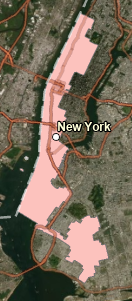Lab 3 [GIS5007]: Cartographic Design
This week’s lab
emphasized applying Gestalt’s Principles of perceptual organization to
cartographic design when creating a map highlighting locations of different
types of schools within a particular ward of Washington, D.C. (Ward 7). Key
software used for the map above was ArcGIS Pro, with the following special
features: curved text, drop shadowing, and label customization. Two excellent
web resources for these features included:
Visual hierarchy was implemented in this map in
the following ways:
- The important map elements (school types as well as legend items for the school names) are graphically emphasized to be more prominent compared to the background city information by using larger and bolded font.
- The neighborhood name information providing context for the location of the schools is emphasized using a larger font and capital letters, but colored in brown to be less prominent than the school naming/type information in black fonts.
- The title and legend are appropriately sized larger than the scale bar and data source information to demonstrate their greater importance to the overall theme.
Contrast was implemented in this map in the
following ways:
- School type symbology is provided in shades of red to contrast with the neutral colors used for the mapped areas and pale yellow background.
- Scaled sizing for the school type is provided within the symbology to readily contrast the different levels of schools (with larger symbols representing higher levels of schools).
- The visual weight of more major transportation routes (e.g., interstate highways) is slightly more than city streets (thin gray colored lines) and in a higher contrasting color (orange) to provide emphasis and context without distracting from the theme.
Figure-ground was implemented in this map in
the following ways:
- Drop shadowing of the map area to contrast with the yellow background in the main map and to contrast with the white background in the inset map.
- The circular symbology selected for the school types along with the contrasting red shades of these items compared to underlying transportation layers makes these objects appear closer, which emphasizes their importance to the theme of the map.
- Screening is used effectively to reduce the visual weight of streets underlying the school and neighborhood name information by making them lighter shades of color (streets) compared to the darker shades used for school symbols, school numbers, and neighborhood naming labels.
- Light gray is used for the within Ward 7 area compared to darker gray outside the ward and darker blue for river areas in keeping with best practices of accentuating the more important ward bound area by making it lighter.
Balance was implemented in this map in the
following ways:
- The overall organization of the map elements effectively minimizes white space through placement of the legends and area of interest inset map.
- The map is visually in equilibrium through the use of a centered title at the top and centered map reference information at the bottom, matched with black background and white lettering.
- The larger legend providing the list of schools is used on the left of the map to balance two items on the right of the map (legend for type of school and inset map).




Comments
Post a Comment